Review of the strategic board game 'Amalfi' aiming to restore the shipping city by managing ships and resources

' Amalfi ' becomes a merchant in the once prosperous shipping city of Amalfi, trades around the world centered on Italy in the 15th century, attracts great people by sales, and invests in paintings and books. It is a board game that aims to revive a deserted city by going there. I tried to play this game, which I call myself a 'heavyweight strategy game', with four editorial staff.
Amalfi Japanese Edition 2nd Edition | uchibacoya piece
◆ 1: Confirmation of contents
◆ 2: Preparation
◆ 3: Start the game
◆ 4: Summary
◆ 1: Confirmation of contents
The 'Amalfi' package looks like this, depicting a city by the sea and a small sailing ship.

The number of players is 1 to 4, the playing time is 90 to 120 minutes, and the target age is 12 years old and over.

In the package, there are a rule book, a black main board, a personal board, an additional personal board, a ship piece in four colors of red, blue, white, and black, a food piece, a colonial piece, a start player marker, and five types of cards. Was included.

The quadruple main board looks like this when unfolded. Maps and card storage from Europe to the Middle East are drawn.

There are four personal boards and four additional personal boards, one for each player.

The personal board is roughly divided into three, the upper part is the five resource spaces of 'spices', 'wheat', 'wine', 'treasure' and 'textile', the center is the sea space, and the lower part is the home country space.

The additional personal board looks like this. The part surrounded by the red frame is the 'food gauge', and the food piece is placed at the position of the number. The bottom is a quick reference of the game flow, and the right is the 'colonial space'.
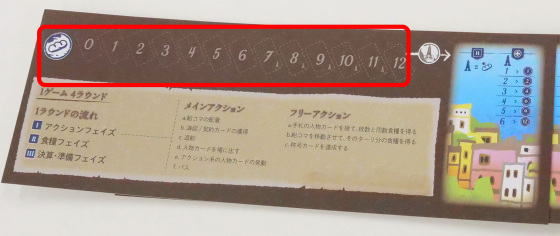
The ship top is in the shape of a ship, and the food top is in the shape of bread. The colonial top is shaped like a lighthouse, and the start player marker is shaped like a compass.

There are five types of cards: contract cards, person cards, nautical chart cards, settlement cards, and title cards.

Contract cards are divided into three types: blue 'buildings', green 'books', and red 'paintings'.

Many real-life greats such as '

Nautical chart cards, settlement cards, and title cards look like this. The sailboat mark, check mark, and ribbon mark are drawn on the back of each.

◆ 2: Preparation
First, place the main board in the center. Shuffle the chart card and turn it face down, and place it as a deck on the left side of the main board. After that, arrange the 5 cards from the top of the deck face up at the position with the sailing ship mark in the center of the main board.

Similarly, after shuffling, place the contract card as a deck on the left side of the main board. Six sheets are placed in the space on the main board.

Randomly select 3 title cards and place them on the right side of the main board. The remaining title cards will not be used, so put them back in the box.
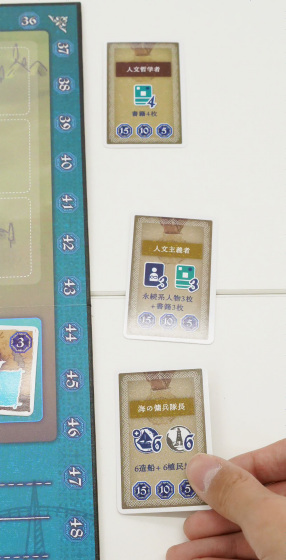
Randomly select 4 settlement cards and arrange them at the check mark on the upper left of the main board. Return the remaining settlement card to the box.

Distribute personal boards and additional personal boards to players. Also, since the 'player who recently boarded the ship' will be the start player, that player will receive the start player marker. In addition, the turn will proceed clockwise from the start player.

Each player chooses a ship piece of their favorite color, 6 of which are the 'sea space' in the middle of the personal board, and the next 6 are the numbers '3' to '8' of the 'shipyard' at the bottom right of the personal board. Place it in position.

Next, place one ship piece at the bottom left of the main board. The left side-upper side-right side of the main board is a 'victory point track', so every time you get a victory point in the game, move this ship to show how much victory point you have just got.
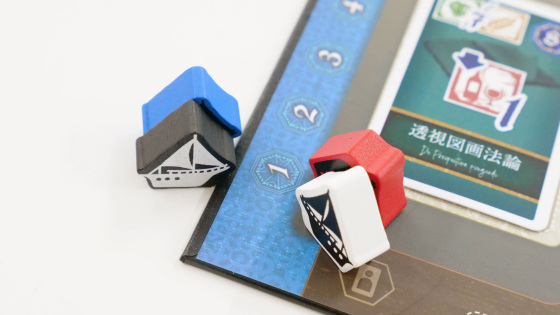
Also, place another ship piece next to '0' in the lower right column of the main board. This shows a track with 50 or more victory points, and every time the victory points exceed 50 points, the ship is moved with '50' and '100'.
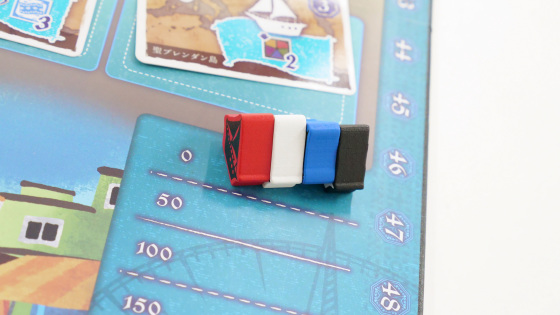
Place the remaining 3 ship pieces one by one next to the three title cards placed in the upper right.
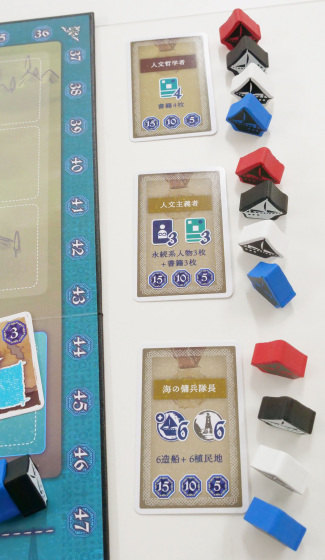
Then place the colonial pieces at positions '7' to '12' on the food gauge on the additional personal board. After that, the start player puts the food piece in '3', the 2nd place is '4', the 3rd place is '5', and the 4th place is '6'.
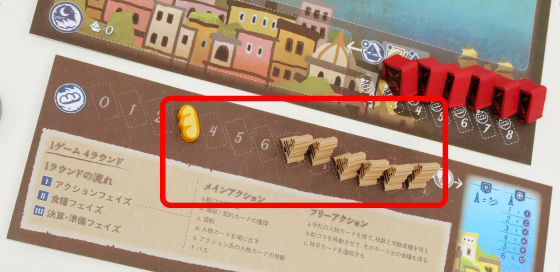
Finally, the placement of the person card. Check the bottom right of the person card and divide it into those with a number icon and those without. Divide the one with the number icon for each number, and give out to everyone the start player a '1' card, the next player a '2' card, and so on. The cards dealt are in each player's hand
, Manage so that only you can see.
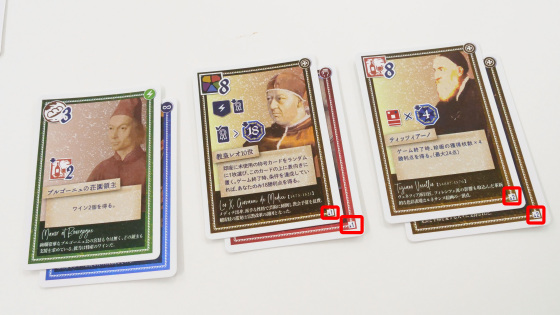
From 'Personal cards without number icons', collect 'Ending cards' and put them in a box. Shuffle the remaining cards, place them face down, take one from the top and place them in the space below the main board. This completes the preparation. In addition, it took about 1 hour to prepare and check the rules at the first play.
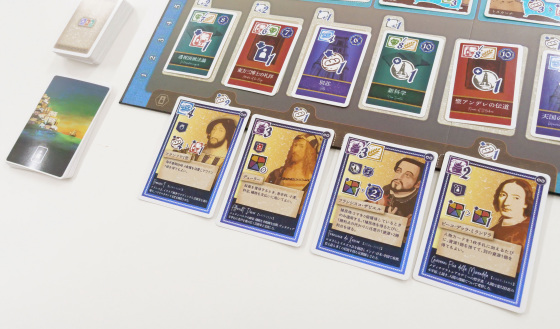
The game has finally started. 'Amalfi' consists of four rounds, and one round is divided into four 'preparation before the start', 'action phase', 'food phase', and 'settlement / preparation phase'.
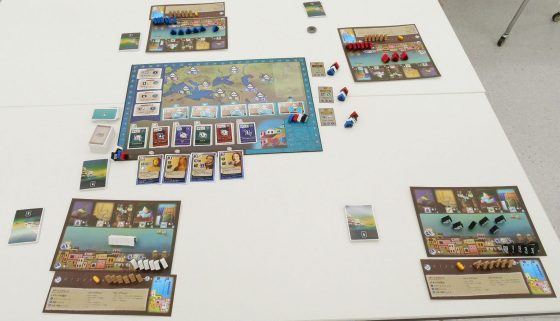
As a ' preparation before the start ' of the round, all players will check the contents of the settlement card on the upper left of the main board. There are four settlement cards, but one from the top is processed for each round, so in this round, the target is 'maximum number of building painting books x 3 victory points'. The contents of the card will be processed during the 'Settlement / Preparation Phase'.
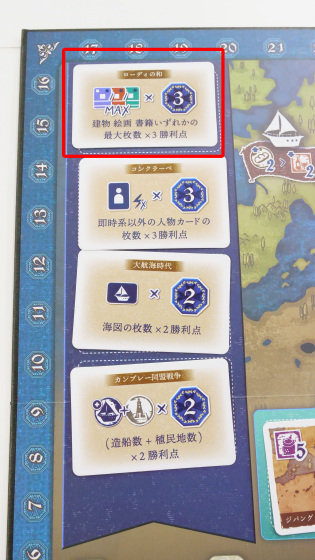
After completing the 'preparation before the start', we will enter the ' action phase ' in order from the start player. In this phase, you can do 6 main actions and 3 free actions. Only one main action can be performed in one phase, but free actions can be executed any number of times at any time during the turn.

The red player performs the main action ' Place Ship Pieces' and moves the ship pieces in the sea space on the personal board to the 'Action Space' where the sailboat icon is drawn on the main board. The action space is an icon that depicts the resources to be paid and the resources and effects to be obtained. The '↑' at the top left of the icon is for payment, the '↓' is for earning, and the number at the bottom right of the icon is the required number for each. In the case of this red ship action, you will pay 2 foods and earn 2 wheat. In addition, it is also an ant to put a ship piece and 'do not pay the cost and do not acquire it'.

The red player moves the food piece from '3' to '1' and pays 2 foods ...
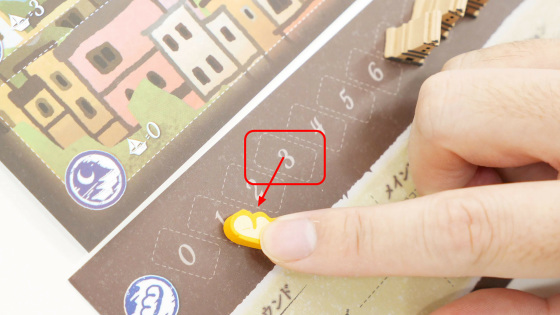
Won 2 wheat. There are no tokens for each resource, and it indicates that you have 'acquired' by moving a ship piece in the sea space to the resource space.
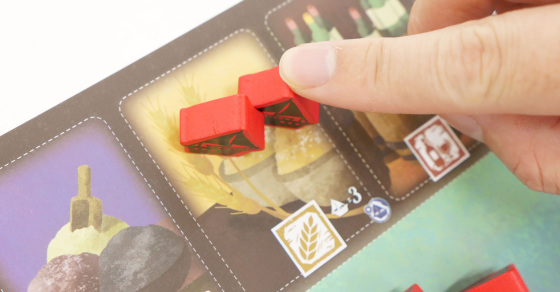
After finishing the main action, there is no free action, so the turn is to the next black player. The black player has placed a ship piece in the action space for 4 food acquisitions, as it is not possible to place a ship piece on top of an action space that already has another ship piece.
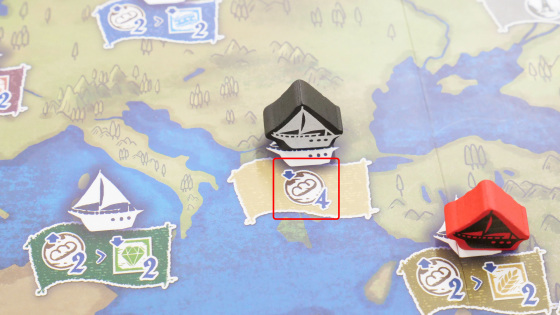
4 The black player who got the food looks like this. Originally, the food gauge could be increased from '4' to '8', but it could only be increased to '6' because of the colonial coma.

Colonial pieces can be removed by placing ship pieces in the action space of the icon like the image.
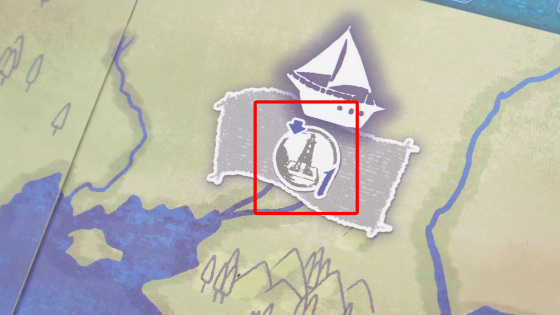
Move the removed colonial pieces to the 'colonial space'.
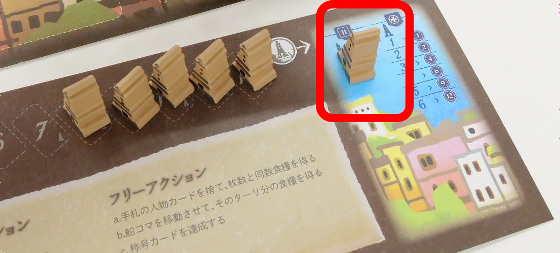
The third blue player consumed 2 foods and earned 3 spices. At first, you only have a 'ship' and 'food' at hand, so you will focus on paying for food and acquiring resources at no cost.
We will repeat the main action with everyone.
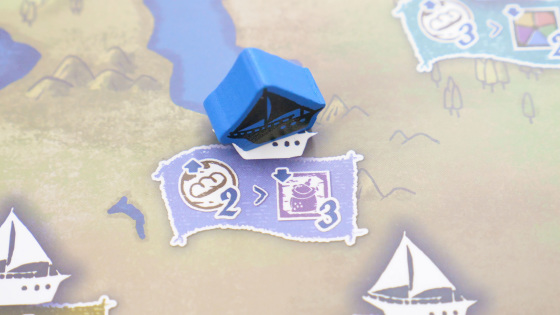
If you have enough resources, you can buy chart cards and contract cards. Each purchase cost is drawn on the top left of the card, but the important point is that the number drawn is not the number of ship pieces placed on the required resources.
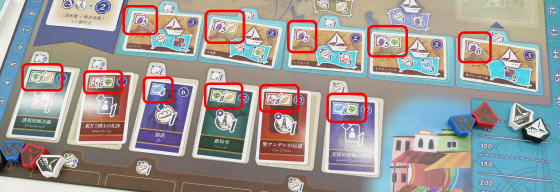
The currency used for purchase is ' Tari ', which is created by 'moving the ship piece from the resource space to the sea space' or 'moving the ship piece from the sea space to the home space'. For example, if you move a ship piece from the 'spices' space to the sea space, you will get 2 tari per ship piece. In the case of wheat, wine, treasure, and textiles, you can get 3 tari per ship piece. However, it is conceptual and there are no coins or tokens. If there is a surplus of Tari at the time of purchase and you need 'change', that number will be converted into food.
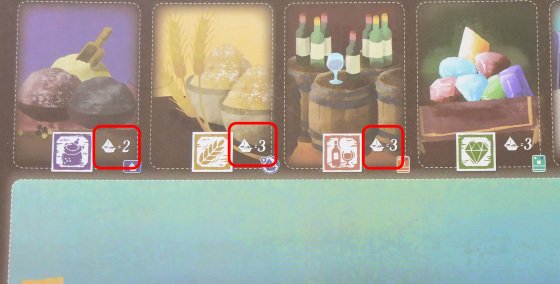
For example, in the case of the chart card '

The blue player, whose turn came around, moved three ship pieces in the spice resource space to the sea space and purchased 'St. Brendan Island'. Place the purchased chart board near your personal board and use it as your own action space.
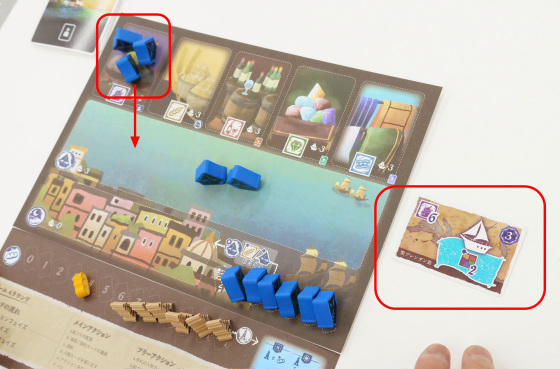
If you really want to buy but you don't have enough tari, you can get 3 tari as ' urgent procurement ' by moving the ship piece in the sea space to your home country space. This Tali is handy because it can be used for any payment, but on the other hand, the ship pieces that have been moved to your home space will not be available until the next round, so it is really a 'last resort'.

The empty nautical chart card space is filled with cards from left to right at the start of the next player's turn, and one card is replenished from the deck.

Additional charts may be required to purchase chart cards and contract cards. You will need an additional 2 tari to purchase the card placed in the leftmost position, and conversely, you will get 1 food when purchasing the card placed in the rightmost position. The newer the card, the higher the cost of acquisition, and the older the card, the more you get a bonus.

The red player generated 6 woven fabric tari and purchased the contract card 'villa'. The cost of the card is 4 tari and an additional 1 tari is consumed, and the extra 1 tari is converted into 1 food. At the time of purchase, the contract card will receive a bonus of the icon drawn in the center. In the case of 'villa', get 1 food. Also, just like when you purchased a nautical chart card, pack the card to the right and replenish one from the deck.

Victory points are written on the upper right of the chart card and contract card. Basically, the victory points in this game will be reflected on the track as soon as you get them, but the victory points written on the chart card and contract card will be calculated at the end of the game. Victory points are roughly proportional to the high and low points and the high and low costs.

Tari is also used to put out cards in the main action 'Put a person card into play'. The white player spawned 3
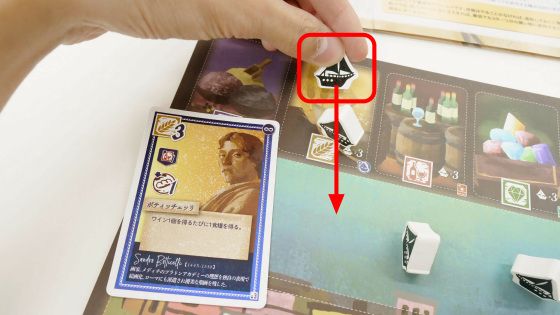
'
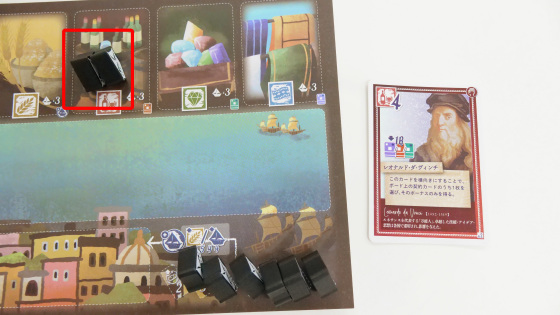
The black player performed the main action ' Activate Action Character Card ' in the next turn and got the bonus of 'Worship of the Three Wise Men'. The bonus of 'Worship of the Three Wise Men' is that 'you will be able to purchase the person card placed in the field'.
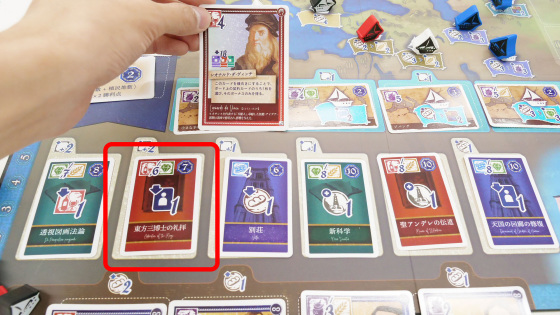
I bought the character card '
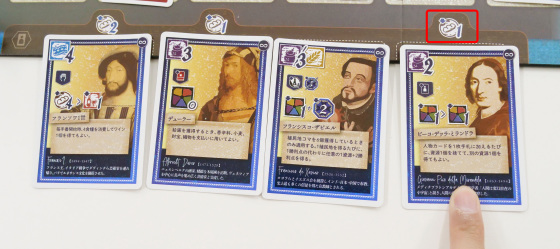
In 'Amalfi', resources are indicated by ship pieces, but ship pieces that have been placed in the action space or moved to the home space by emergency procurement will not return until the next round. Therefore, it is very important at what timing to perform ' shipbuilding ' to increase the number of ships. 'Shipbuilding' consumes wheat or tari obtained from emergency procurement. The number of consumption varies from round to round, with 6 tari in the first round, 5 tari in the second round, and 4 tari in the 3rd and 4th rounds. The ship pieces you made will be available from the next round.

You can take some action while the ship piece is in the resource space or the sea space, but when you finally have nothing to do, take the main action ' pass '. Once you 'pass', your turn will not come around in the action phase of this round. The action phase continues until all players 'pass'.
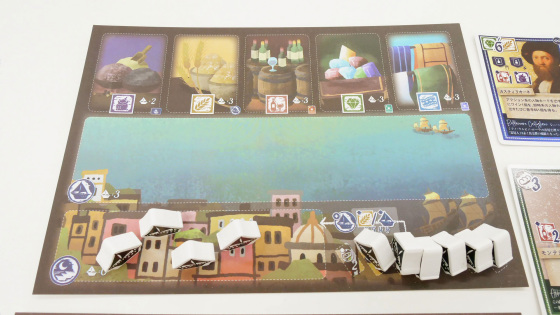
After the action phase, the next is the ' food phase '. You will get 1 food for each colony you have acquired. Next, check the shipyard and lose food by the rightmost value of the numbers you can see. If no ship is built, 2 foods will be used, and after that, the consumption will increase by 1 for each ship built, and 8 foods will be lost when the maximum of 6 ships is built. This phase is processed in the order of acquisition → consumption, and if you run out of food, you will lose 3 victory points for each shortage. Victory points cannot be less than 0.
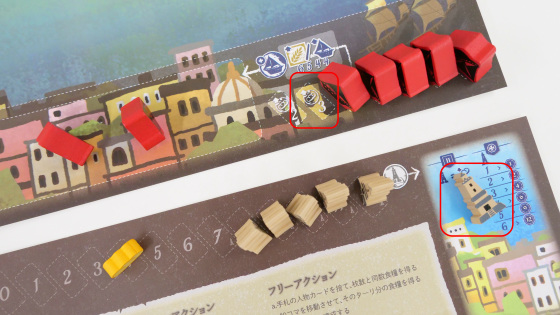
The last is the ' Financial Statement / Preparation Phase '. First, settle the account based on the contents of the settlement card confirmed first, and move the ship piece on the victory point truck on the main board. Turn over the top card and the second closing card will be closed in the next round.
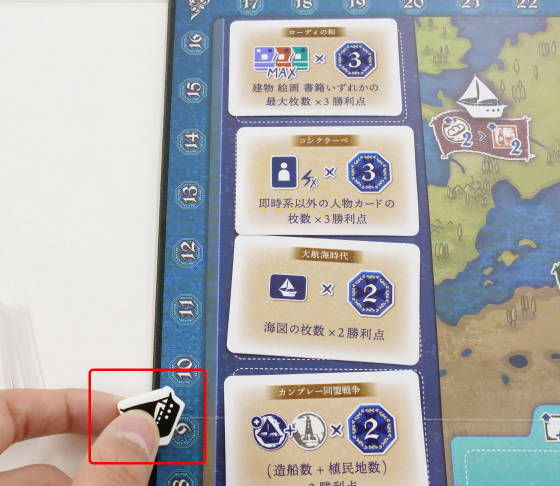
Move the chart card on the far right of the main board to the bottom of the empty space above. This chart card will be treated as an 'additional action space' and you will be able to place ship pieces from the next round. Since space is available, right-justify the chart cards and replenish the cards from the deck on the left end.
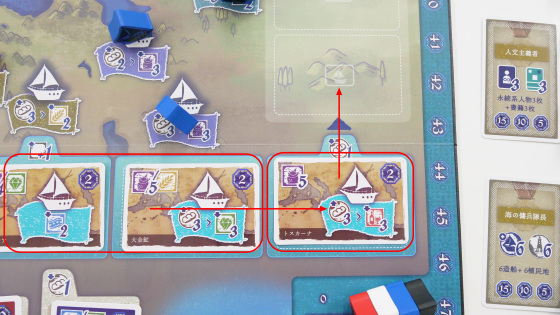
For the contract card, remove the two cards on the right side from the main board as discard cards, right-justify them, and then replenish two cards from the deck.
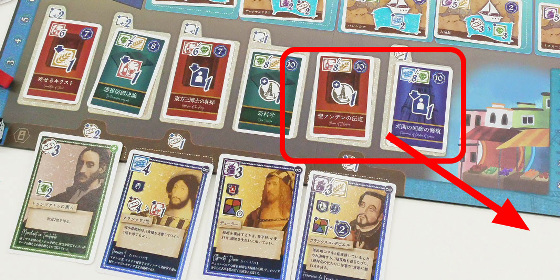
Each player collects all his ship pieces in the action space and home space and moves them to the sea space. If you used an action person card and turned it horizontally, turn it back to portrait.

This is the end of the first round. At this point, 90 minutes, which is originally a guideline for gameplay time, has passed.
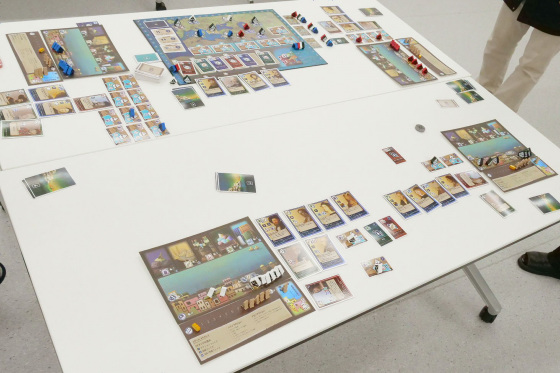
As I got used to the second round, I hope that my hands will go smoothly. Meanwhile, the white player has achieved the 'Title Card' condition. The title card 'Humanities Philosopher' can get victory points by collecting 4 contract cards of 'Books'. The white player had a character card 'Pope Alexander VI' in play that would '-1 any condition when achieving all title cards', so he achieved the condition with 3 book cards. ..
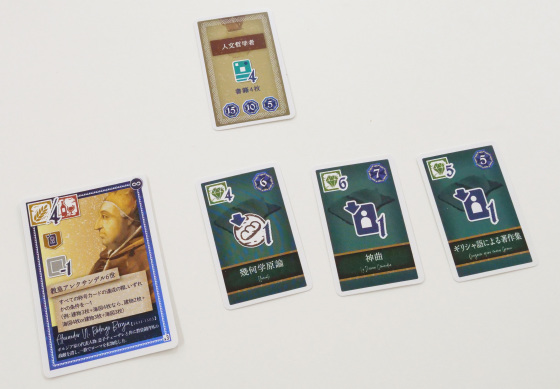
The ship piece was placed on the far left of the victory point icon on the title card, and 15 victory points were obtained. The next player to achieve has 10 victory points, the next has 5 points, and the player who achieved first has more victory points.
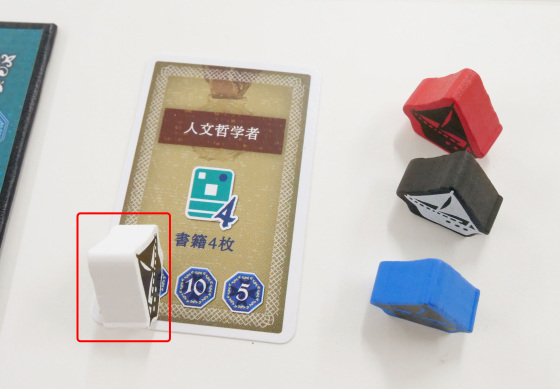
Since the hand is different for each player, the play style changes greatly depending not only on the content of the trade but also on which person card is used. For example, a black player puts a lot of character cards into play and tries to efficiently obtain resources by stacking multiple effects.
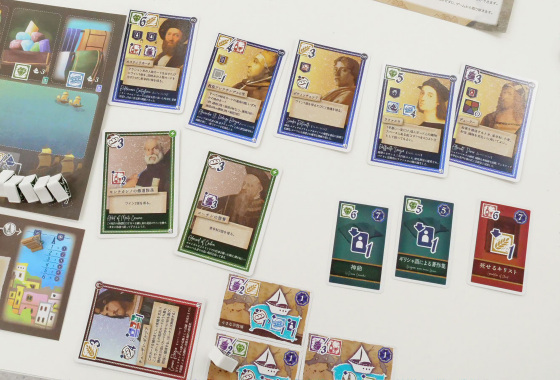
On the other hand, the red player was steadily changing the character card to food with the free action 'discard the person card and get food', saying 'the hand does not live in the current style'.
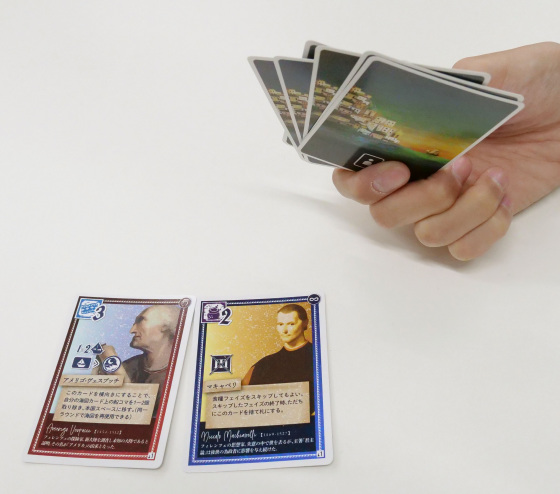
A blue player who buys a nautical chart card saying, 'This space alone is too small for the world.' The blue player was also aiming for the third round settlement card 'Number of charts x 2 victory points' while expanding the chances of getting resources.
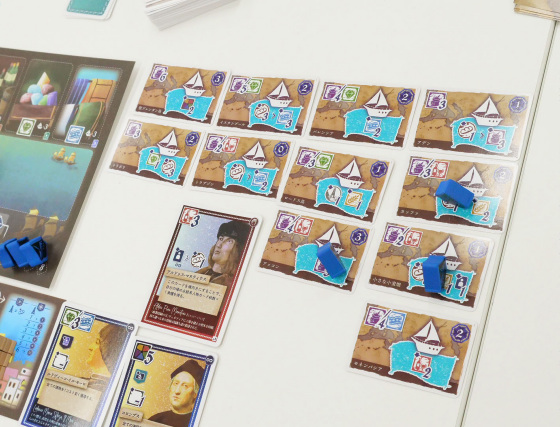
As a result of this action, the chart card runs out in the middle of the third round. When the deck runs out, the chart card will be up to that point and will not be replenished.

As you repeat the rounds, the range of things you can do will expand. Following the hoarding of nautical charts, the blue player achieved 6 shipbuilding and 6 colonial acquisitions, and succeeded in earning the title of 'Mercenary Captain of the Sea'.
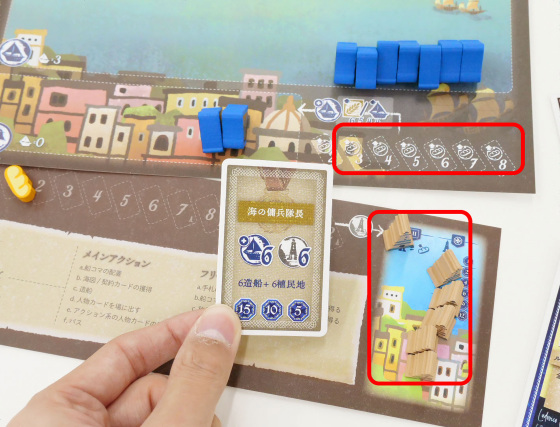
If everyone 'passes' in the action phase of the fourth round, the game ends after the food phase and the settlement phase. Enter the score calculation.

In addition to the value of the victory point track that should have advanced considerably, the victory points according to the number of colonies acquired, the victory points of the acquired chart card and contract card, and the victory points of the end-of-life character card are added, and the final Victory points are calculated. The black player who put out the character card was unexpectedly sluggish and scored 51 points. Meanwhile, the blue player who bought up the chart won with 156 points.

◆ 4: Summary
It took about 4 hours from the start of preparation to the end of the game, and I got the impression that the word 'heavyweight' is true. However, this is because we proceeded from reading the rules, and if everyone understands the rules, we can proceed with the play more crisply. Since only one main action can be performed in one action phase, the choices of actions are not too wide and it does not take too much time to think, and it is unlikely that the turn will end without doing anything. There is not much stress during the turn. Also, since the five types of cards are rich in content, they rarely have the same shape and can be played as many times as you like. Since there are many cards, there is an advantage for experienced players who have some understanding of the card contents, but there is no route that 'this is a win' among multiple possible play styles, and it was a game that I wanted to challenge again. ..
'Amalfi' can be purchased from the official sales page, and the price is 7600 yen including tax.
Amalfi Japanese Edition 2nd Edition | uchibacoya piece
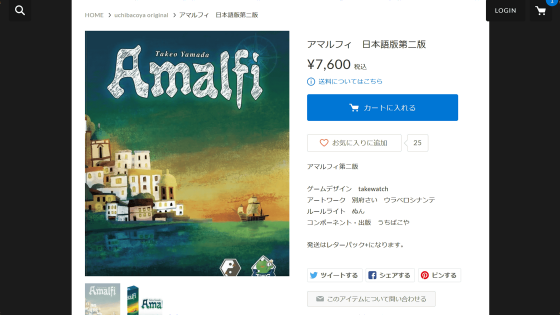
Related Posts:







